Linear Mixed-Effects Model to Quantify the Association between Somatic Cell Count and Milk Production in Italian Dairy Herds
Abstract
Simple Summary
Abstract
1. Introduction
2. Materials and Methods
2.1. Study Data
2.2. Milk Sampling and Analysis
2.3. Data Editing
2.4. Statistical Analysis
3. Results
3.1. Descriptive Analysis
3.2. Statistical Analysis
3.3. The Fit of the Model
4. Discussion
5. Conclusions
Supplementary Materials
Author Contributions
Funding
Institutional Review Board Statement
Informed Consent Statement
Data Availability Statement
Acknowledgments
Conflicts of Interest
References
- Halasa, T.; Huijps, K.; Østerås, O.; Hogeveen, H. Economic effects of bovine mastitis and mastitis management: A review. Vet. Q. 2007, 29, 18–31. [Google Scholar] [CrossRef] [PubMed]
- Hogeveen, H.; Huijps, K.; Lam, T.J.G.M. Economic aspects of mastitis: New developments. New Zealand Vet. J. 2011, 59, 16–23. [Google Scholar] [CrossRef] [PubMed]
- Ruegg, P.L.; Petersson-Wolfe, C.S. Mastitis in Dairy Cows. Vet. Clin. N. Am. Food Anim. Pract. 2018, 34, ix. [Google Scholar] [CrossRef] [PubMed]
- Hogeveen, H.; Steeneveld, W.; Wolf, C.A. Production Diseases Reduce the Efficiency of Dairy Production: A Review of the Results, Methods, and Approaches Regarding the Economics of Mastitis. Annu. Rev. Resour. Econ. 2019, 11, 289–312. [Google Scholar] [CrossRef]
- Hadrich, J.; Wolf, C.; Lombard, J.; Dolak, T. Estimating milk yield and value losses from increased somatic cell count on US dairy farms. J. Dairy Sci. 2018, 101, 3588–3596. [Google Scholar] [CrossRef]
- Huijps, K.; Lam, T.J.; Hogeveen, H. Costs of mastitis: Facts and perception. J. Dairy Res. 2008, 75, 113–120. [Google Scholar] [CrossRef]
- Van Soest, F.; Santman-Berends, I.M.; Lam, T.J.; Hogeveen, H. Failure and preventive costs of mastitis on Dutch dairy farms. J. Dairy Sci. 2016, 99, 8365–8374. [Google Scholar] [CrossRef]
- Zecconi, A.; Zanirato, G. Il Controllo delle Mastiti per un Allevamento Sostenibile; Filiera AQ—Università degli Studi di Milano: Bologna, Italy, 2013. [Google Scholar]
- Zecconi, A.; Dell’Orco, F.; Rizzi, N.; Vairani, D.; Cipolla, M.; Pozzi, P.; Zanini, L. Cross-sectional study on the prevalence of contagious pathogens in bulk tank milk and their effects on somatic cell counts and milk yield. Ital. J. Anim. Sci. 2019, 19, 66–74. [Google Scholar] [CrossRef]
- Alhussien, M.N.; Dang, A. Milk somatic cells, factors influencing their release, future prospects, and practical utility in dairy animals: An overview. Vet. World 2018, 11, 562–577. [Google Scholar] [CrossRef]
- Farre, M.; Zecconi, A.; Kelton, D. Bulletin 515: Guidelines for Defining Quarter and Udder Health Status and Cured Clinical and subclinical Mastitis Cases; IDF: Bruxelles, Belgium, 2022. [Google Scholar]
- Zecconi, A.; Vairani, D.; Cipolla, M.; Rizzi, N.; Zanini, L. Assessment of subclinical mastitis diagnostic accuracy by differential cell count in individual cow milk. Ital. J. Anim. Sci. 2019, 18, 460–465. [Google Scholar] [CrossRef]
- Halasa, T.; Nielen, M.; De Roos, A.; Van Hoorne, R.; de Jong, G.; Lam, T.; van Werven, T.; Hogeveen, H. Production loss due to new subclinical mastitis in Dutch dairy cows estimated with a test-day model. J. Dairy Sci. 2009, 92, 599–606. [Google Scholar] [CrossRef] [PubMed]
- Hand, K.; Godkin, A.; Kelton, D. Milk production and somatic cell counts: A cow-level analysis. J. Dairy Sci. 2012, 95, 1358–1362. [Google Scholar] [CrossRef] [PubMed]
- Gonçalves, J.L.; Cue, R.I.; Botaro, B.G.; Horst, J.A.; Valloto, A.A.; Santos, M.V. Milk losses associated with somatic cell counts by parity and stage of lactation. J. Dairy Sci. 2018, 101, 4357–4366. [Google Scholar] [CrossRef] [PubMed]
- Chen, H.; Weersink, A.; Kelton, D.; von Massow, M. Estimating milk loss based on somatic cell count at the cow and herd level. J. Dairy Sci. 2021, 104, 7919–7931. [Google Scholar] [CrossRef]
- Hagnestam-Nielsen, C.; Emanuelson, U.; Berglund, B.; Strandberg, E. Relationship between somatic cell count and milk yield in different stages of lactation. J. Dairy Sci. 2009, 92, 3124–3133. [Google Scholar] [CrossRef]
- Kirk, J.H. Programmable Calculator Program for Linear Somatic Cell Scores to Estimate Mastitis Yield Losses. J. Dairy Sci. 1984, 67, 441–443. [Google Scholar] [CrossRef]
- Nieuwenhuis, R.; Manfred, T.G.; Pelzer, B. Influence.ME: Tools for Detecting Influential Data in Mixed Effects Models. R J. 2012, 4, 38–47. [Google Scholar] [CrossRef]
- Bates, D.; Mächler, M.; Bolker, B.; Walker, S. Fitting Linear Mixed-Effects Models Using lme4. J. Stat. Softw. 2015, 67, 48. [Google Scholar] [CrossRef]
- Penati, C.A.; Tamburini, A.; Bava, L.; Zucali, M.; Sandrucci, A. Environmental impact of cow milk production in the central Italian Alps using Life Cycle Assessment. Ital. J. Anim. Sci. 2013, 12, 584–592. [Google Scholar] [CrossRef]
- Seegers, H.; Fourichon, C.; Beaudeau, F. Production effects related to mastitis and mastitis economics in dairy cattle herds. Vet. Res. 2003, 34, 475–491. [Google Scholar] [CrossRef]
- Green, L.; Schukken, Y.; Green, M. On distinguishing cause and consequence: Do high somatic cell counts lead to lower milk yield or does high milk yield lead to lower somatic cell count? Prev. Vet. Med. 2006, 76, 74–89. [Google Scholar] [CrossRef] [PubMed]
- Yue, X.; Steeneveld, W.; van der Voort, M.; van Schaik, G.; Vernooij, J.C.; van Duijn, L.; Veldhuis, A.M.; Hogeveen, H. The effect of bovine viral diarrhea virus introduction on milk production of Dutch dairy herds. J. Dairy Sci. 2021, 104, 2074–2086. [Google Scholar] [CrossRef] [PubMed]
- Macciotta, N.; Mele, M.; Conte, G.; Serra, A.; Cassandro, M.; Zotto, R.D.; Borlino, A.C.; Pagnacco, G.; Secchiari, P. Association between a Polymorphism at the Stearoyl CoA Desaturase Locus and Milk Production Traits in Italian Holsteins. J. Dairy Sci. 2008, 91, 3184–3189. [Google Scholar] [CrossRef] [PubMed]
- Abeni, F.; Calamari, L.; Stefanini, L.; Pirlo, G. Effect of average daily gain on body size, metabolism, and milk production of Italian Holstein heifers raised on two different planes of nutrition and calving at two different ages. Livest. Sci. 2012, 149, 7–17. [Google Scholar] [CrossRef]
- Bellingeri, A.; Cabrera, V.; Gallo, A.; Liang, D.; Masoero, F. A survey of dairy cattle management, crop planning, and forages cost of production in Northern Italy. Ital. J. Anim. Sci. 2019, 18, 786–798. [Google Scholar] [CrossRef]
- Wilson, D.; González, R.; Hertl, J.; Schulte, H.; Bennett, G.; Schukken, Y.; Gröhn, Y. Effect of Clinical Mastitis on the Lactation Curve: A Mixed Model Estimation Using Daily Milk Weights. J. Dairy Sci. 2004, 87, 2073–2084. [Google Scholar] [CrossRef]
- Liang, D.; Wood, C.; McQuerry, K.; Ray, D.; Clark, J.; Bewley, J. Influence of breed, milk production, season, and ambient temperature on dairy cow reticulorumen temperature. J. Dairy Sci. 2013, 96, 5072–5081. [Google Scholar] [CrossRef]
- Ray, D.; Halbach, T.; Armstrong, D. Season and Lactation Number Effects on Milk Production and Reproduction of Dairy Cattle in Arizona. J. Dairy Sci. 1992, 75, 2976–2983. [Google Scholar] [CrossRef]
- Long, J.S.; Ervin, L.H. Using Heteroscedasticity Consistent Standard Errors in the Linear Regression Model. Am. Stat. 2000, 54, 217–224. [Google Scholar] [CrossRef]
- Schielzeth, H.; Dingemanse, N.J.; Nakagawa, S.; Westneat, D.F.; Allegue, H.; Teplitsky, C.; Réale, D.; Dochtermann, N.A.; Garamszegi, L.Z.; Araya-Ajoy, Y.G. Robustness of linear mixed-effects models to violations of distributional assumptions. Methods Ecol. Evol. 2020, 11, 1141–1152. [Google Scholar] [CrossRef]
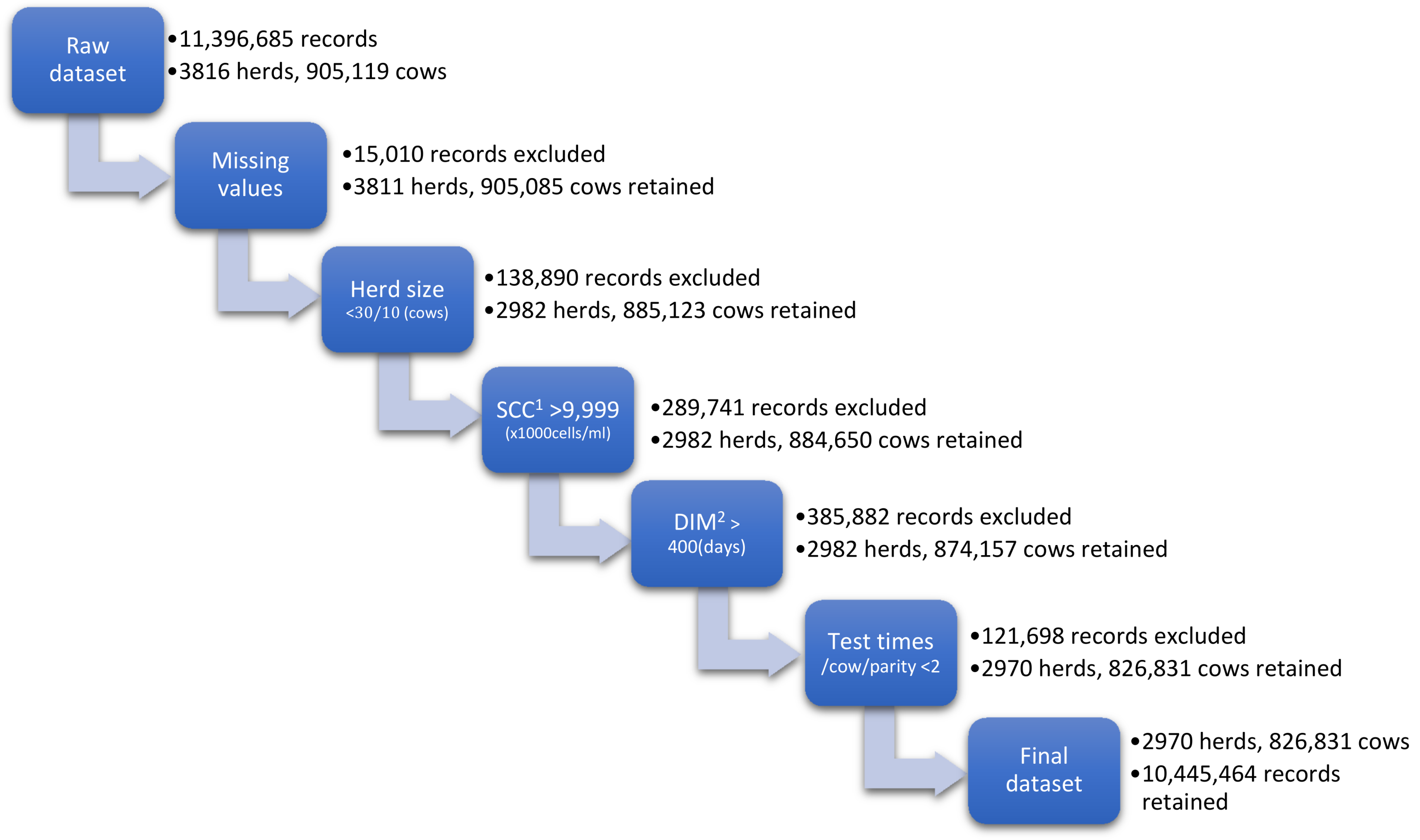
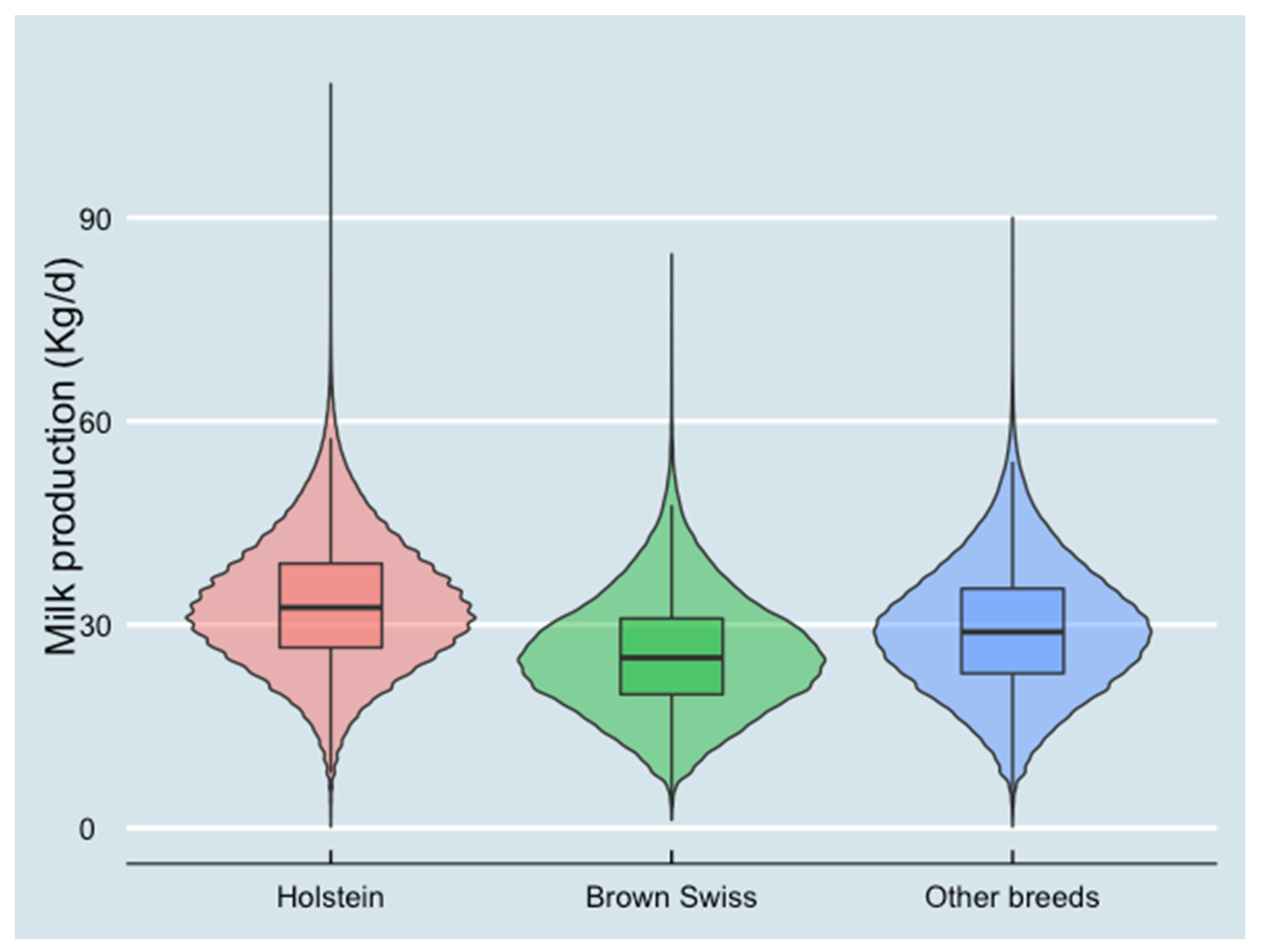

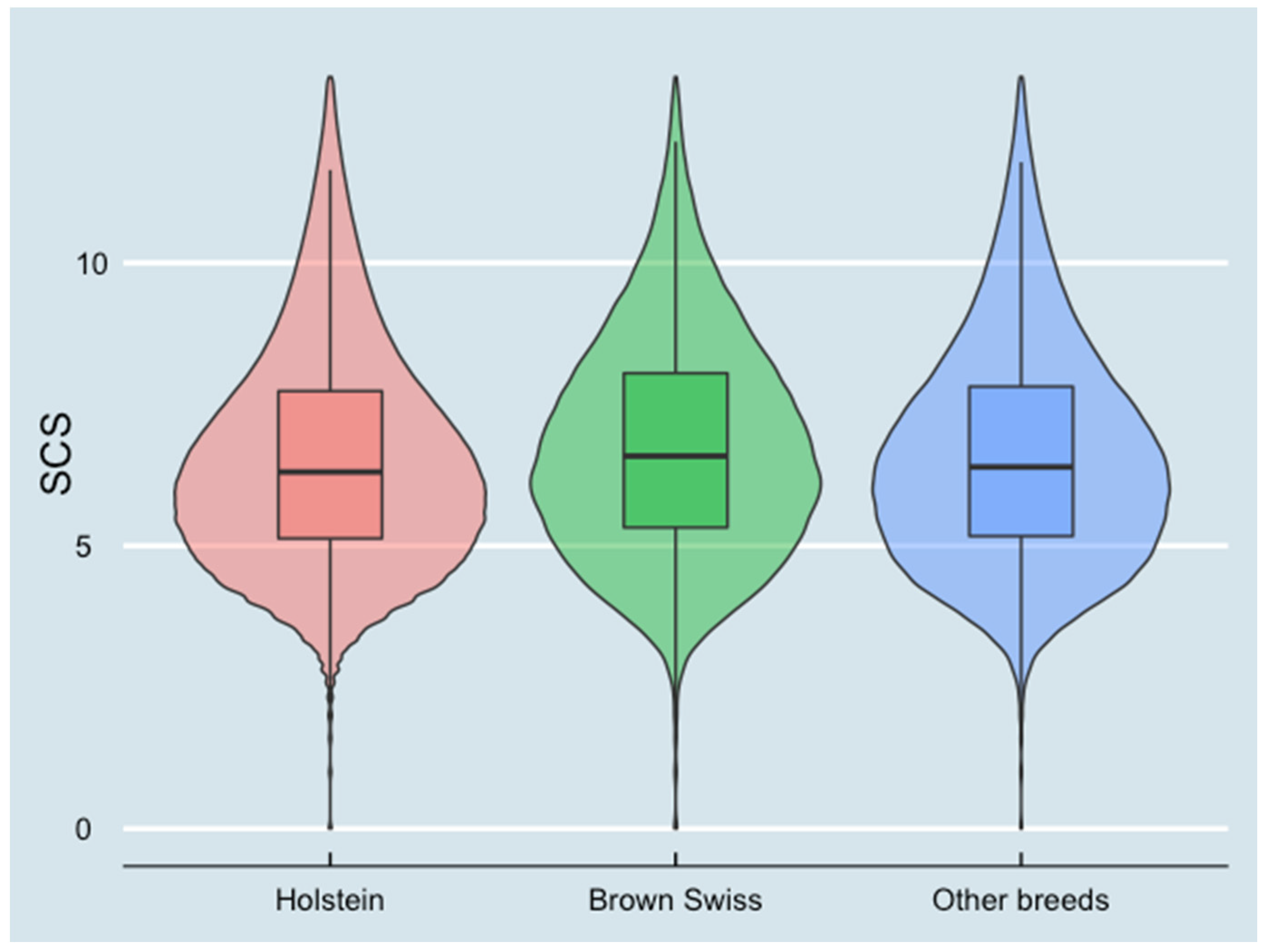
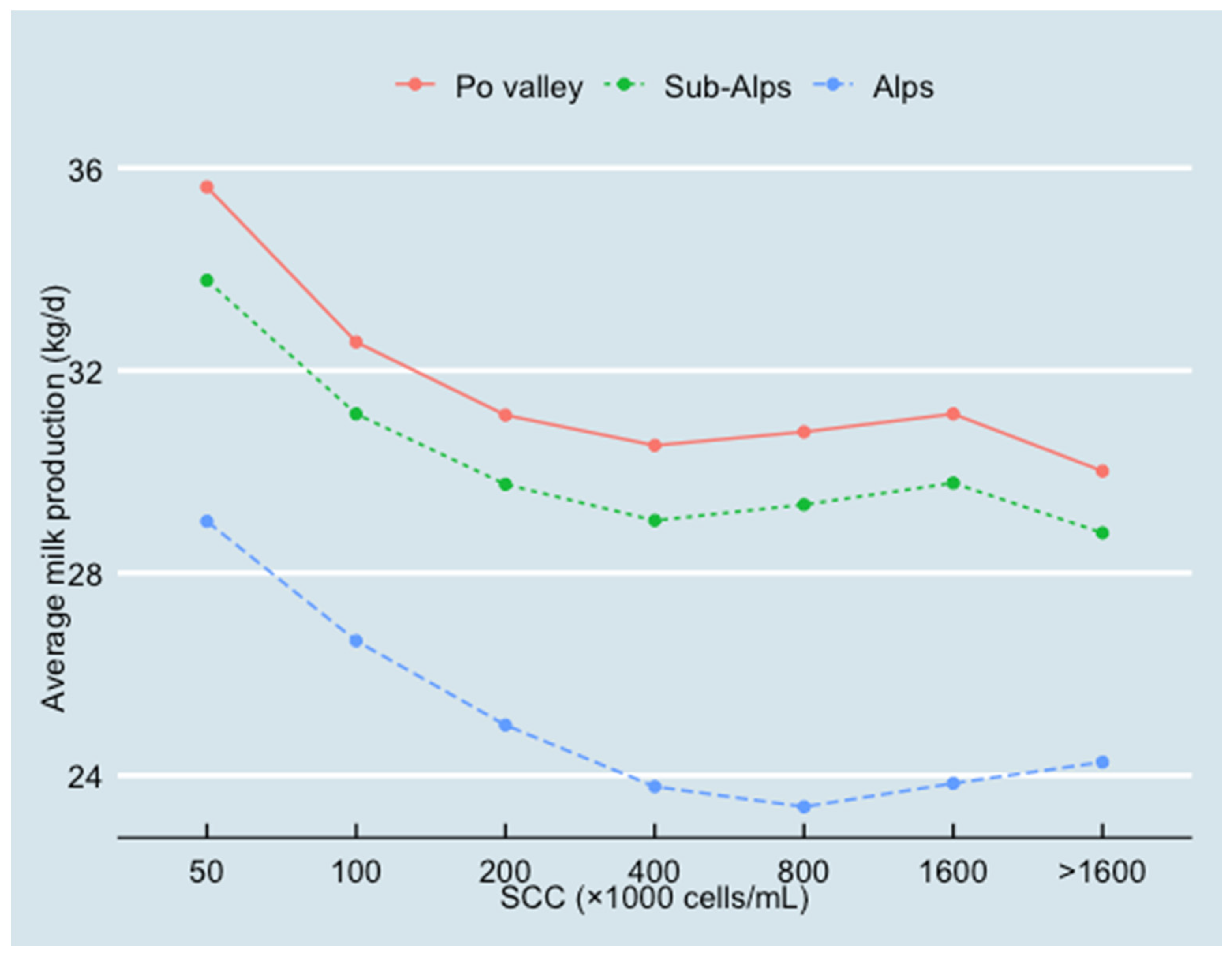
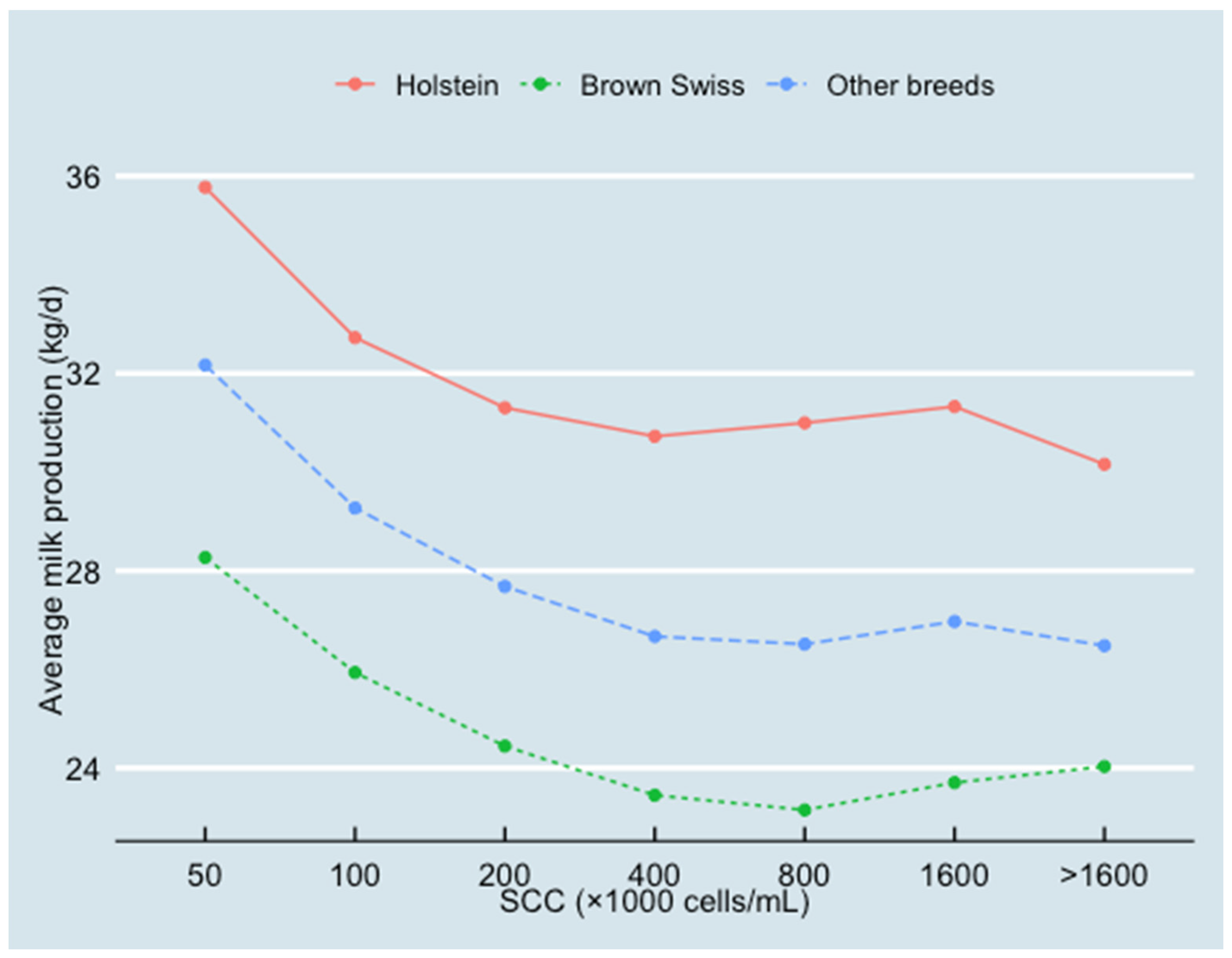
| Geographical Area | Breed Type | % of Total Test Day Records |
|---|---|---|
| Po Valley | Holstein | 94.2% |
| Brown Swiss | 1.0% | |
| Other breeds | 4.8% | |
| Sub-Alps | Holstein | 85.8% |
| Brown Swiss | 7.1% | |
| Other breeds | 7.2% | |
| Alps | Holstein | 42.8% |
| Brown Swiss | 35.2% | |
| Other breeds | 22.0% |
| Independent Variables | Estimated Coefficients (β) | Lower 95% CI | Upper 95% CI | |
|---|---|---|---|---|
| Intercept | 34.750 ***2 | 34.593 | 34.907 | |
| SCS 1 | −0.830 *** | −0.832 | −0.828 | |
| Area | Po Valley | Ref. 3 | ||
| Sub-Alps | −1.354 ** | −2.385 | −0.324 | |
| Alps | −6.750 *** | −7.386 | −6.115 | |
| Breed | Holstein | Ref. | ||
| Brown Swiss | −4.639 *** | −4.761 | −4.516 | |
| Other breeds | −1.447 *** | −1.500 | −1.394 | |
| Parity | Parity 1 | Ref. | ||
| Parity 2 | 3.588 *** | 3.576 | 3.599 | |
| Parity 3+ | 5.112 *** | 5.095 | 5.128 | |
| Season | Autumn | Ref. | ||
| Spring | 1.912 *** | 1.902 | 1.922 | |
| Summer | 0.228 *** | 0.217 | 0.239 | |
| Winter | 1.427 *** | 1.416 | 1.437 | |
| Year | 2016 | Ref. | ||
| 2017 | 0.153 *** | 0.143 | 0.164 | |
| 2018 | 0.338 *** | 0.325 | 0.351 | |
| Overall | Alps | Sub-Alps | Po valley | |||||||||||||||||
|---|---|---|---|---|---|---|---|---|---|---|---|---|---|---|---|---|---|---|---|---|
| Min. | Median | Mean | Max. | SD | Min. | Median | Mean | Max. | SD | Min. | Median | Mean | Max. | SD | Min. | Median | Mean | Max. | SD | |
| Herd size (nr of cows) | 10 | 176 | 228 | 1099 | 179 | 10 | 47 | 86 | 369 | 93 | 30 | 89 | 109 | 269 | 67 | 30 | 179 | 233 | 1099 | 179 |
| Milk production (kg/d) | 0.2 | 32.2 | 32.8 | 109.7 | 9.6 | 0.6 | 25.7 | 26.3 | 92.6 | 9.1 | 1.2 | 30.9 | 31.5 | 87.6 | 9.2 | 0.2 | 32.4 | 32.9 | 110 | 9.6 |
| SCC1 (x 103 cells/mL) | 1 | 80 | 308 | 9999 | 779 | 1 | 91 | 319 | 999 | 737 | 1 | 73 | 274 | 9938 | 710 | 1 | 80 | 308 | 9999 | 780 |
| Fat (%) | 2.0 | 3.8 | 3.9 | 7.0 | 0.8 | 2.0 | 4.1 | 4.2 | 7.0 | 0.8 | 2.0 | 3.9 | 3.9 | 7.0 | 0.7 | 2.0 | 3.8 | 3.9 | 7.0 | 0.8 |
| Protein (%) | 1.5 | 3.4 | 3.4 | 6.0 | 0.4 | 1.6 | 3.6 | 3.6 | 6.0 | 0.4 | 2.0 | 3.1 | 3.4 | 5.8 | 0.4 | 1.5 | 3.4 | 3.4 | 6.0 | 0.4 |
| DIM2 (day) | 5 | 162 | 170 | 399 | 102 | 5 | 158 | 168 | 399 | 104 | 5 | 162 | 170 | 399 | 103 | 5 | 158 | 168 | 399 | 104 |
Disclaimer/Publisher’s Note: The statements, opinions and data contained in all publications are solely those of the individual author(s) and contributor(s) and not of MDPI and/or the editor(s). MDPI and/or the editor(s) disclaim responsibility for any injury to people or property resulting from any ideas, methods, instructions or products referred to in the content. |
© 2022 by the authors. Licensee MDPI, Basel, Switzerland. This article is an open access article distributed under the terms and conditions of the Creative Commons Attribution (CC BY) license (https://creativecommons.org/licenses/by/4.0/).
Share and Cite
Luo, T.; Steeneveld, W.; Nielen, M.; Zanini, L.; Zecconi, A. Linear Mixed-Effects Model to Quantify the Association between Somatic Cell Count and Milk Production in Italian Dairy Herds. Animals 2023, 13, 80. https://doi.org/10.3390/ani13010080
Luo T, Steeneveld W, Nielen M, Zanini L, Zecconi A. Linear Mixed-Effects Model to Quantify the Association between Somatic Cell Count and Milk Production in Italian Dairy Herds. Animals. 2023; 13(1):80. https://doi.org/10.3390/ani13010080
Chicago/Turabian StyleLuo, Tiantian, Wilma Steeneveld, Mirjam Nielen, Lucio Zanini, and Alfonso Zecconi. 2023. "Linear Mixed-Effects Model to Quantify the Association between Somatic Cell Count and Milk Production in Italian Dairy Herds" Animals 13, no. 1: 80. https://doi.org/10.3390/ani13010080
APA StyleLuo, T., Steeneveld, W., Nielen, M., Zanini, L., & Zecconi, A. (2023). Linear Mixed-Effects Model to Quantify the Association between Somatic Cell Count and Milk Production in Italian Dairy Herds. Animals, 13(1), 80. https://doi.org/10.3390/ani13010080





